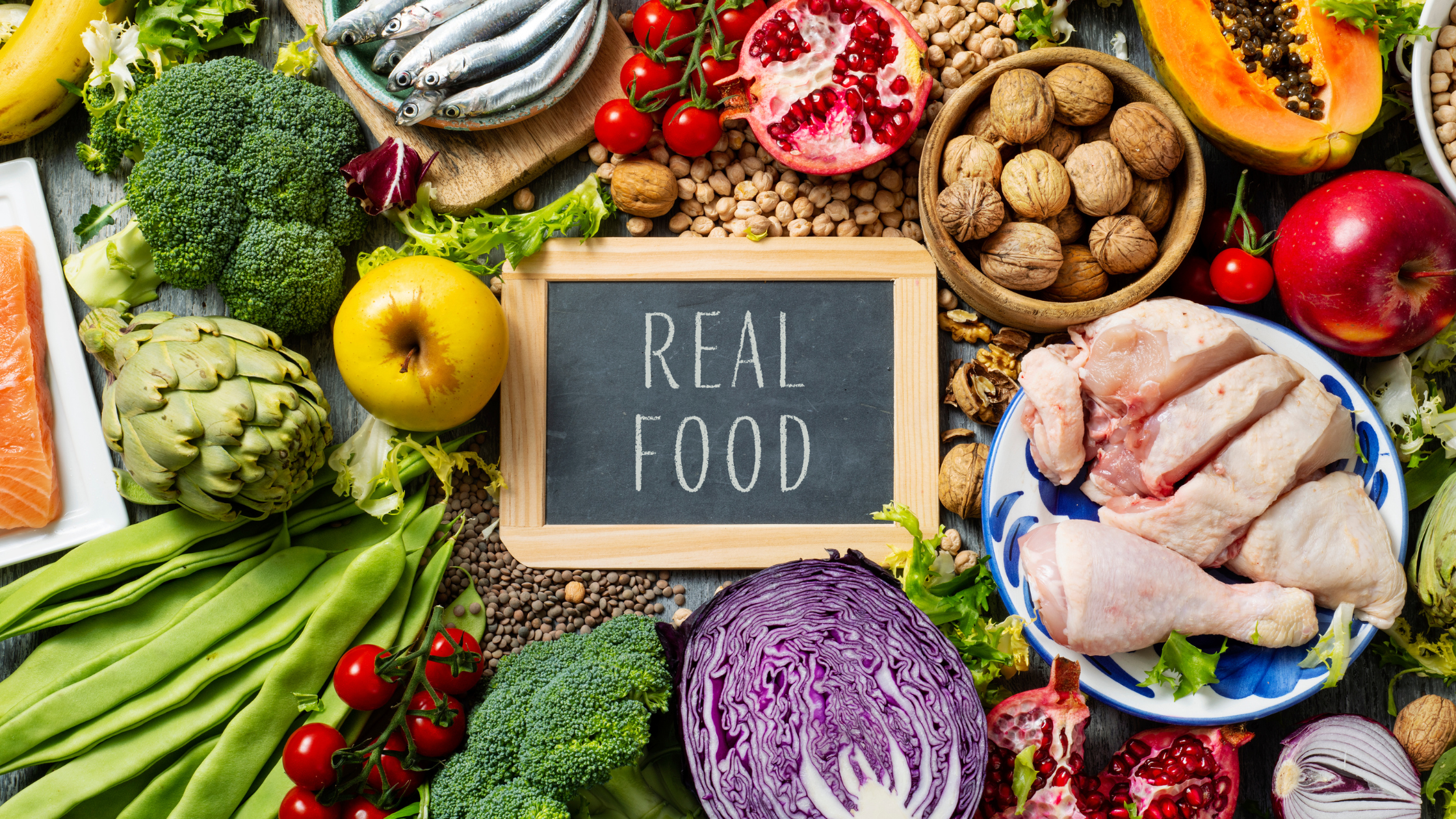
All posts by Mira


Anxiety, Mold, And The Hidden Threats To Your Wellbeing
Food Choices, Stress, and Mold Connection
The link between food choices, stress, and mold is significant. While convenient and processed foods were introduced to save time, they have had lasting negative effects on public health. These foods, rich in additives but low in nutrition, harm both the body and mind.
In the midst of a busy lifestyle, stress can dysregulate the nervous system, leading to various symptoms and illnesses, including heightened anxiety levels.
Anxiety acts as a natural alarm, signaling underlying issues that need attention. One such issue is the toxic aftermath of mold exposure, a hidden intruder that can be as harmful as it is widespread. G
Given the interconnectedness of the nervous and immune systems, taking a proactive approach is crucial to protect against unseen threats in your environment.
Mold Sickness Symptoms and Healing
Mold sickness presents a range of symptoms, from neurologic disruptions to immune suppression, posing a challenge in recognition due to potential misdiagnosis or undervaluation in healthcare.
Actions to Take:
- Meditate Regularly: Begin with meditation to calm your nervous system, creating a foundation to implement lifestyle changes.
- Nourish Your Body: Prioritize a diet that supports your body’s healing from mold-induced inflammation.
- Beware of Misdiagnosis: Understand that environmental factors such as mold toxicity may be overlooked in mainstream medicine, leading to ineffective treatments.
- Seek Positive Support: Engage with communities that focus on healing and avoid hopeless discussions.
- Embrace Nature: Reconnect with natural rhythms and adopt healthier living habits to counteract modern lifestyle-induced hypersensitivity.
Learn more how to protect yourself from mold sickness by watching my interview with Dr. Traci Potterf below:

Transform Stress Into Peace And Power With Rapid Eye Technology
What is Rapid Eye Technology
How it Works
Applying RET to your Daily Life
In Conclusion
Sign up to get your free worksheet!
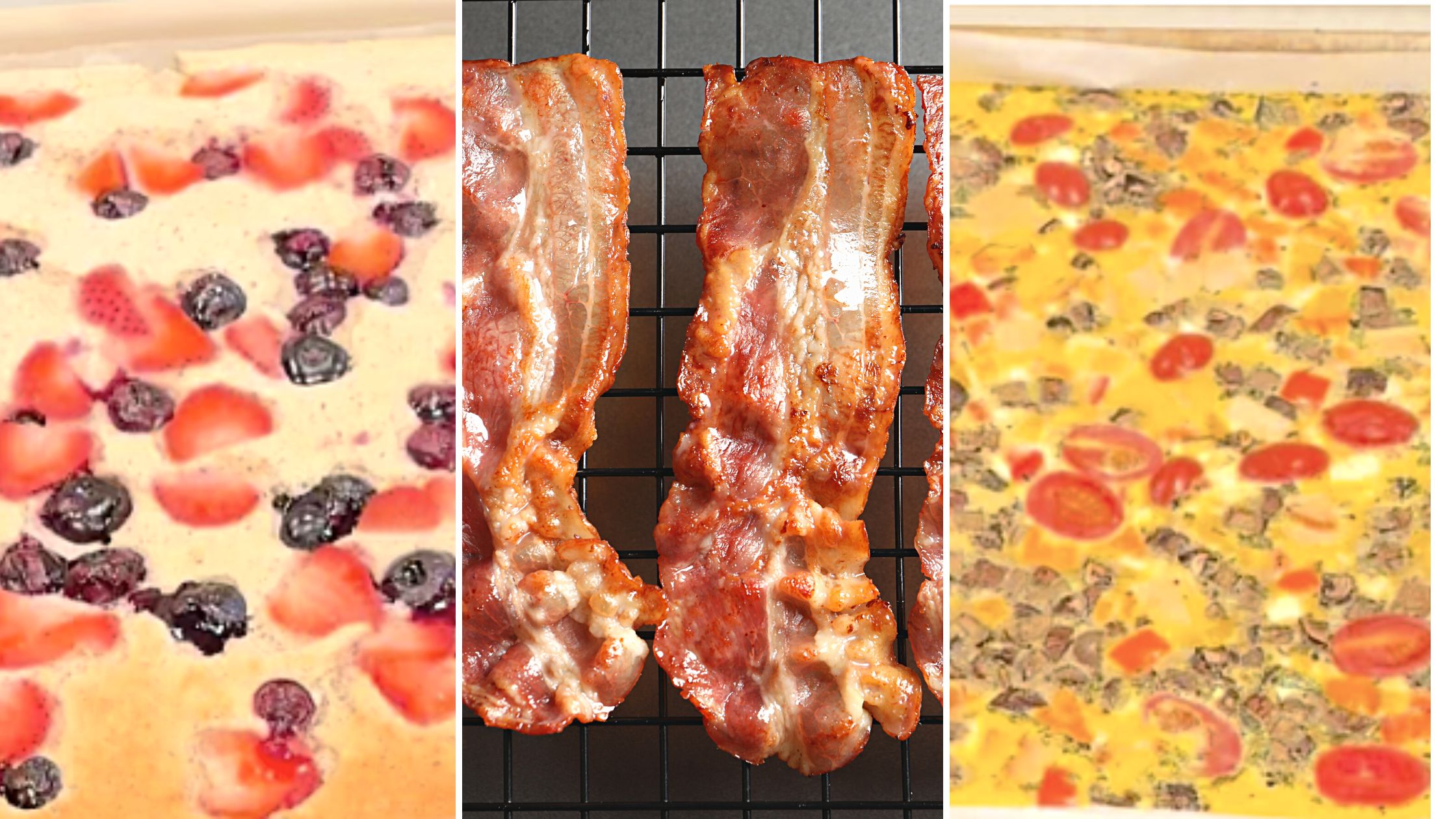
Sheet Pan Breakfast
- In sharing these recipes I've chosen my favorite add-ins, feel free to substitute the vegetable or fruits of your choice.
- If you're making all three recipes at once you'll need three racks in your oven. If you don't have three racks you can use a footed cooling rack to make a space. Place the footed rack into the bacon, not the other dishes.
- When making the eggs and pancakes it's helpful to use unbleached parchment paper for an easier cleanup. Lightly brush the tray with a little oil to help the parchment paper stick, lay down the paper, and then lightly oil the paper. I know it seems like a lot of work but cleanup is so much better when you do it this way
- Chop and dice ingredients as needed before beginning the assembly process
- The timing doesn't come out exact for all the recipes (meaning they don't all finish cooking at the same time) but it's close enough
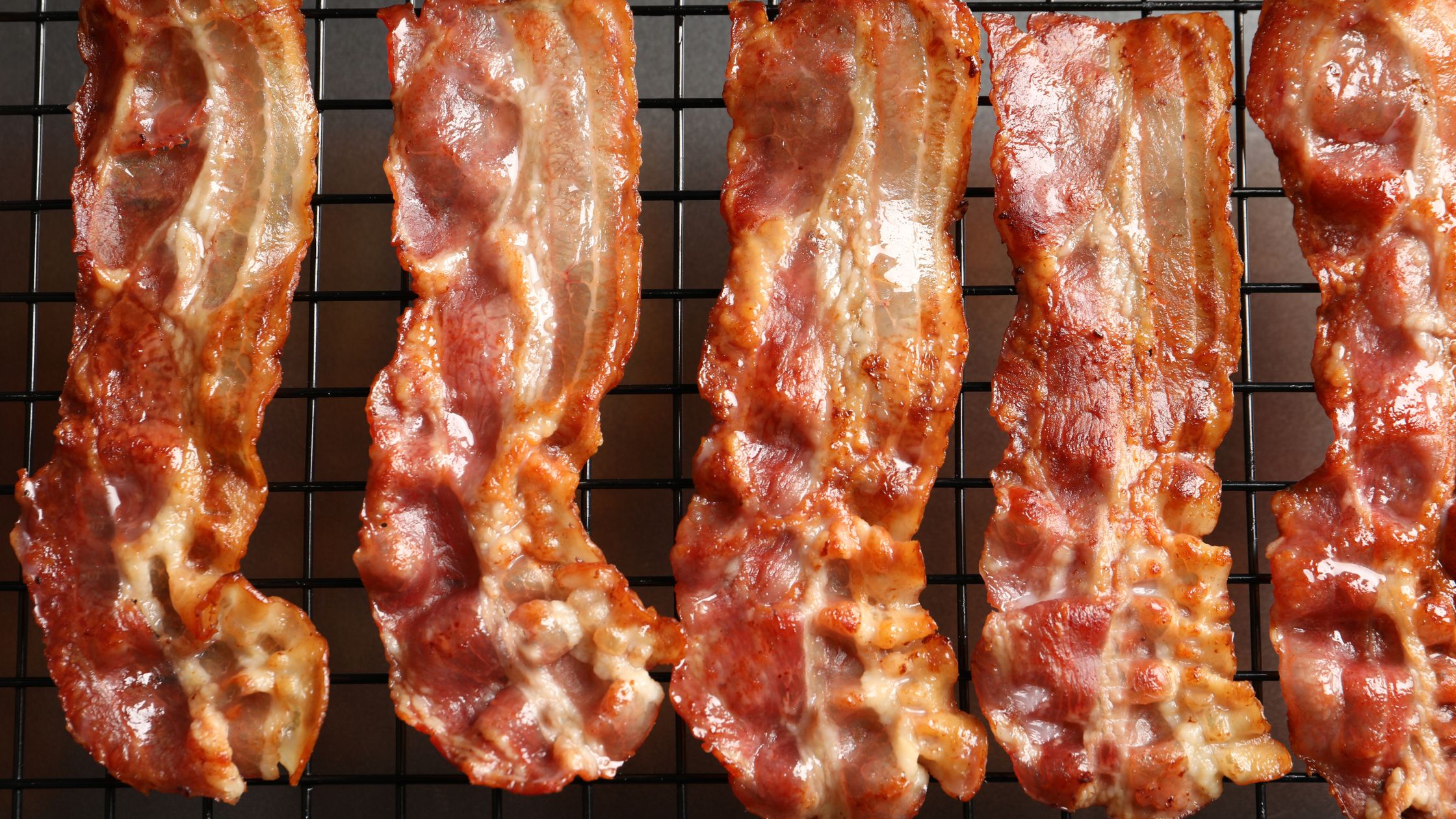
Sheet Pan Bacon
Ingredients
- 1 pound uncured bacon, preferably from pasture-raised pigs
Instructions
- Preheat oven to 425°F
- Add parchment paper to the baking tray
- Place a cooling rack (flat) on the tray
- Lay out the strips of bacon on the rack
- Place the tray in the oven on the bottom rack
- The bacon will take 30-45 minutes to cook depending on thickness and crispiness preference so you'll need to keep an eye on it
- When bacon is cooked to your preference remove it from the rack and pat dry with toweling to remove excess grease
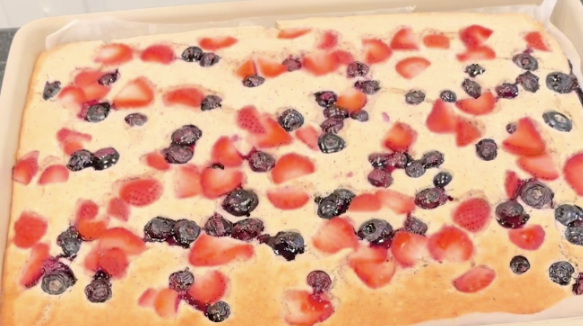
Sheet Pan Pancakes
Ingredients
- 2 cups gluten-free flour blend, such as King Arthur's Measure for Measure
- 1/4 cup ground flaxseed
- 5 teaspoon baking powder (yes I know it's a lot, trust me on this)
- 1 teaspoon salt
- 1 Tablespoon organic sugar
- 2 eggs
- 1/3 cup organic milk
- 1/3 cup avocado oil
- 2 teaspoons vanilla
- 1 1/2 cups water
- 3 cups fruit - I tend to use mixed berries but chopped apples or pears would work well here too
Instructions
- Prepare a tray with parchment
- Whisk together dry ingredients
- Then add liquid ingredients and blend until fully combined and the batter is smooth
- Pour mixture into pan and spread into an even layer
- Top with fruit, if using apples or pears dust with cinnamon
- Bake 5 minutes
- Reduce heat to 350°F and bake for another 10 minutes or until pancake is firm and bounces back when tapped
- Remove from oven, slice, and serve with maple syrup or jam
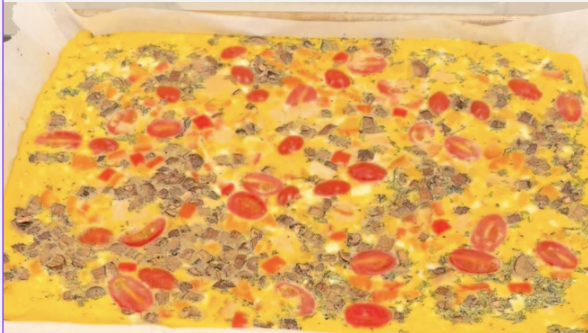
Sheet Pan Eggs
Ingredients
- 18 eggs
- 1/3 cup organic milk
- 1 1/2 teaspoons dried parsley
- 1 teaspoon dried basil
- 1 teaspoon sea salt
- 1 teaspoon black pepper
- 1/2 cup diced mushrooms
- 1/3 cup diced bell peppers
- 1/2 cup diced cherry tomatoes
- 1/2 cup diced lunchmeat, optional
- 1 - 1 1/2 cups shredded organic cheese, optional
- Guacamole
- Hot sauce
Instructions
- Prepare a tray with parchment
- In a mixing bowl blend eggs, milk, herbs, salt, and pepper until well combined
- Pour eggs into pan
- Sprinkle veggies over the top of the egg mixture
- Sprinkle with lunchmeat if using
- Sprinkle with cheese, if using
- Bake 15 minutes or until eggs are firm and bounce back when tapped
- Remove from oven
- Slice and serve with guacamole and hot sauce

Pantry Pests
- Beetles, there are so many different kinds. The most commonly found beetles include drugstore, confused, saw-toothed, spider beetles, warehouse, and flour beetles. They tend to target pantry staples like flour and grains. Infested food should be discarded, especially because warehouse beetle larvae hairs may trigger an allergic reactions if consumed.
- Cockroaches are the worst. There are several different kinds and sizes. They tend to swarm your trash or possibly get into your dishwasher (remember to clean that dishwasher food trap out regularly) and their droppings may cause allergies.
- Indian Meal Moths. These are those little flyers that love setting up shop in your pantry. They usually come in with flour or pasta from the store and can lay hundreds of eggs, causing a real hassle. This is part of why I encourage freezing grains and flours before putting them into the pantry. It won’t stop them, but it can help reduce their numbers.
- Pharaoh Ants. These tiny yellow or light brown ants tend to alternate between a desire for carb-rich and then protein-rich foods. Unfortunately while they’re looking for their next food fix, they may find your pantry.
- Spiders can sometimes be found hanging around in your pantry, especially if there’s an infestation of other bugs they can eat.
- Weevils are tiny bugs that feast on rice, barley, corn, and oats. They’re so small that they show up simply as dark specs in the flour or grain.
- Yellow Mealworms love damp, moldy food, so if you spot them, the item was likely already expired or got too damp.
What Pantry Pests Like to Eat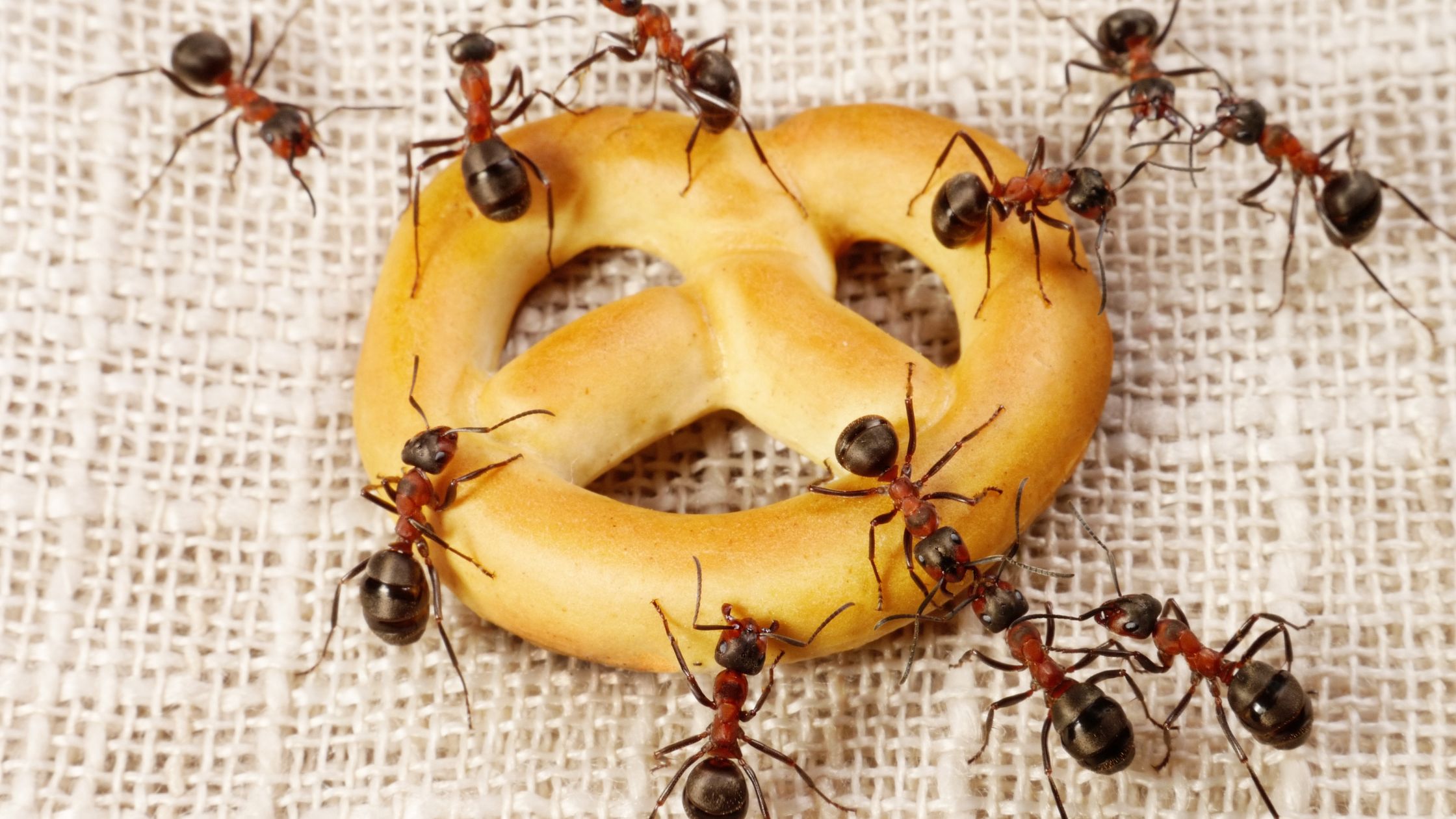
- Cookies
- Cornmeal or corn kernels
- Crackers
- Flour
- Legumes - beans and peas
- Nuts and seeds - and flours made from them
- Pasta
- Powdered milk
- Spices
- Sugar
- Sugary drink mixes
How to Keep Pests out of Your Food Storage
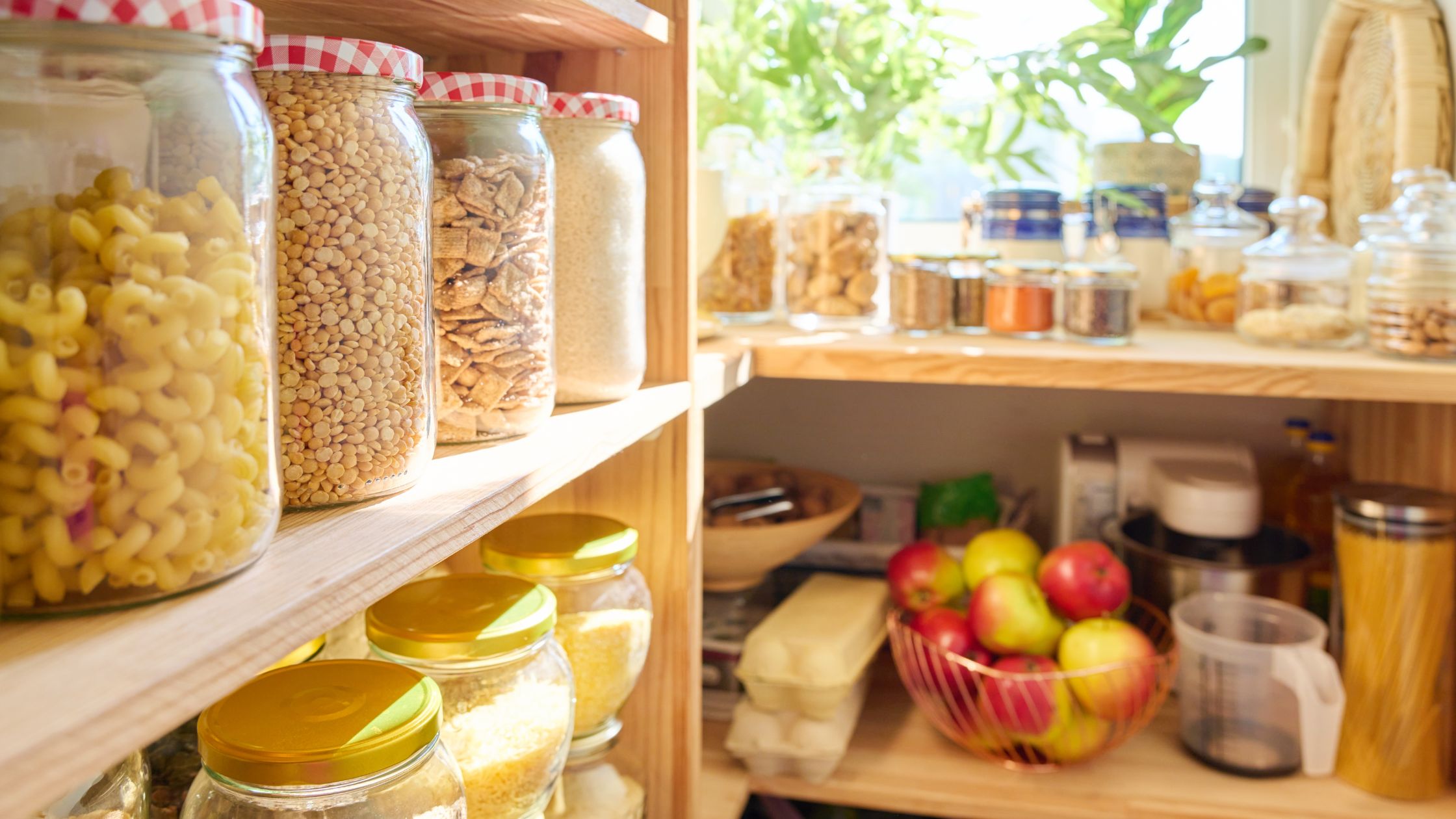
In conclusion

Word Of The Year
Back in 2013 I was challenged by a business coach to pick a word of the year. A single word that would encompass my goals and guide me for the year ahead. Each year since then I've continued to go through the process of picking a word.
This year word that resonates the most with me is Clarity.
2024 Word of the Year: Clarity
ˈklarɪti
noun
the quality of being coherent and intelligible.
the quality of being certain or definite.
the quality of transparency or purity.
the quality of being easy to see or hear; sharpness of image or sound.
2023 was a very full year. Who am I kidding? The last few years have been over-full, challenging, and more than a little overwhelming for everyone. I think we all have been through a maelstrom, and are just now beginning to wake up from the chaos and confusion that started in 2020 with the advent of Covid.
As I look back over the previous year, I am noticing a pattern. It's become apparent that I have narrowed my focus on certain things in my life, both personally and professionally. I realize, in this narrowing down, that what I am doing is making the way clear for what is to come next. I am making room to be more focused and more present. I’m also making room for opportunity and change to show up and be available in my life. By simplifying, by clarifying, I'm essentially unmuddying the waters of my life.
So much of the work I do in sharing about ingredients, focusing on preparedness, and sharing holistic health and wellness information is already about helping others like you learn and see and notice what's impacting them and their lives. It's about educating and equipping you to make informed choices. It's about making things clearer and more transparent. Plus, I believe the more you know the more you notice. That has an echo of clarity to as well.
Focusing on clarity and what lies ahead will, I think, help make life less stressful. It feels like clarity also brings the promise of abundance. I'm excited to see how clarity will show up for me in the year that lies ahead of us.
As I learn to open up to the light of clarity in my own life, I'm also looking forward to sharing what I learn with those in my community and supporting them on their clearer and more defined wellness journey.
I think it's going to be a beautiful year ahead.
Previous Words
- 2023- Celebrate
- 2022 - Illuminate
- 2021 - Brave
- 2020 - Authenticity
- 2019 - Simple
- 2018- Change
- 2017 - Mindfulness
- 2016 - Focus
- 2015 - Balance
- 2014 - Inspire
PS If you have celebrations that are joyful and warming to your heart, or books that resonate with this theme for you I'd like to hear about them. I'd also love to know if you've chosen a word for 2023 and what it is. You can drop a comment in the online community.

The Gratitude Issue
Gratitude is what's on my mind right now. We're at that annual cusp from old year to new. That time when so many people make resolutions, often unrealistic and undefined. And by doing so set themselves up to feel bad about themselves later. There are a number of studies that show how beneficial a gratitude practice can be, mentally, emotionally, and physically, to support our overall health and wellness.
The gratitude jar
I believe anytime is a perfect time to think about gratitude. But I especially love this ritual that I've built up over time around creating an abundance of gratitude in my life.
For the past few years I've had a jar sitting next to my desk in my office. When I have a moment of gratitude (and it can be for anything, not specifically for work, personal, others in my life) I write it down on a little scrap of paper and throw it in the jar. I confess that I try to find colorful scraps of paper because it's more fun that way. I don't go back through the jar throughout the year, I just keep filling it up.
Come New Year's Eve while I'm waiting for the countdown, I open the jar and empty it out. I unfold all those pieces of paper and savor reading them one by one. I do this by myself, but you may choose to do it with friends or family members too. It can be fun if it's a group jar or if several people bring their jars and go through them together.
I find I do remember many of them, but what always strikes me is the number of things that I forgot about. Every. Single. Year. These are moments I was grateful for when they happened, but in the hustle and bustle of everyday life they slipped into the back of my memory and got buried there. In opening this jar and going through them, I am grateful for those moments again.
Some people write all of their gratitudes down in a book that they keep from year to year. I have another friend who glues down all her little scraps into a composition book of gratitude. I don't do any of those things, mine go into the compost bin. But I truly love this ritual look back over the year. This ability in spite of any challenges or low moments we may have faced to see so many wonderful things. So many reasons to be grateful.
Once the jar is empty it almost seems to sparkle as I set it next to my desk to begin again. And it brings hope and a cheerful spirit as I anticipate the year ahead.
Cultivating a habit of gratitude
Being grateful doesn't always come easy. For some reason we are surrounded by a culture (and a news media) that brings out the worst in us. Often we get so overwhelmed that we allow the negative things to strongly influence how we percieve what is happening around us. Amidst the explosions of stress, worry, and overwhelming circumstance, the little sparks of gratitude can sometimes get lost. Just as we learn to read and write and do any of the other things we've learned to do in life, so too we need to learn to cultivate the habit of gratitude.
Below are some of my favorite resources and articles on the topic. I am not going to lie and tell you that I live in that blissed out place that is continual gratitude. I don't. I sometimes struggle to get there, to get anywhere close to being grateful. And yet I know I have to very much to be grateful for.
Yes we can get overwhelmed, sometimes we get lost. But I have come to believe that by remembering that concept of gratitude and by trying to pay attention to it I am happier overall. And so I've collected these resources and I have my ritual of the gratitude jar. I'm excited and looking forward to what this new year will bring.
As we transition to another year I hope that whatever the year ahead holds for you it also brings happiness, health, contentment, and peace.
Gratitude resources
How To Be Grateful To People We Don't Like – Learning to look at negative situations and focus on the good things we have can help us achieve a transformational shift. Admittedly this is not always easy to do, but sometimes having a resource we can turn to the guide us toward this can be helpful.
Gratefulness.org – A wonderful website offering videos, audios, articles, a virtual labyrinth, and virtual candles you can light. This is one of my favorite resources.
How Gratitude Can Change Your Life – A good article about gratitude with some information about how studies showing how it can improve your life.
Why Living a Life of Gratitude Can Make You Happy – A few suggestions for ways to add a gratitude practice to your life.
Stumbling Toward Gratitude – The end of this article sums it up well, ” There are no miracles. … There are no long-term quick fixes for happiness, so if you become a more grateful person and you add [these] exercises to your repertoire, you’ll be different six months or a year from now.”
9 Ways To Cultivate Gratitude – Nine suggestions for ways to cultivate gratitude (and avoid focusing on criticism or complaints)
A Serving of Gratitude May Save The Day – This New York Times article has some great suggestions and offers gentle ways to get started
And here's a video on gratitude that I found moving. Thanks to my Aunt for sharing it just when I needed it.
Gratitude: A Mindful Pause – if you happen to be in the market for a sweet gratitude journal. This one has both unlined and lined pages making it perfect for both writing and drawing, coloring, or art journaling.
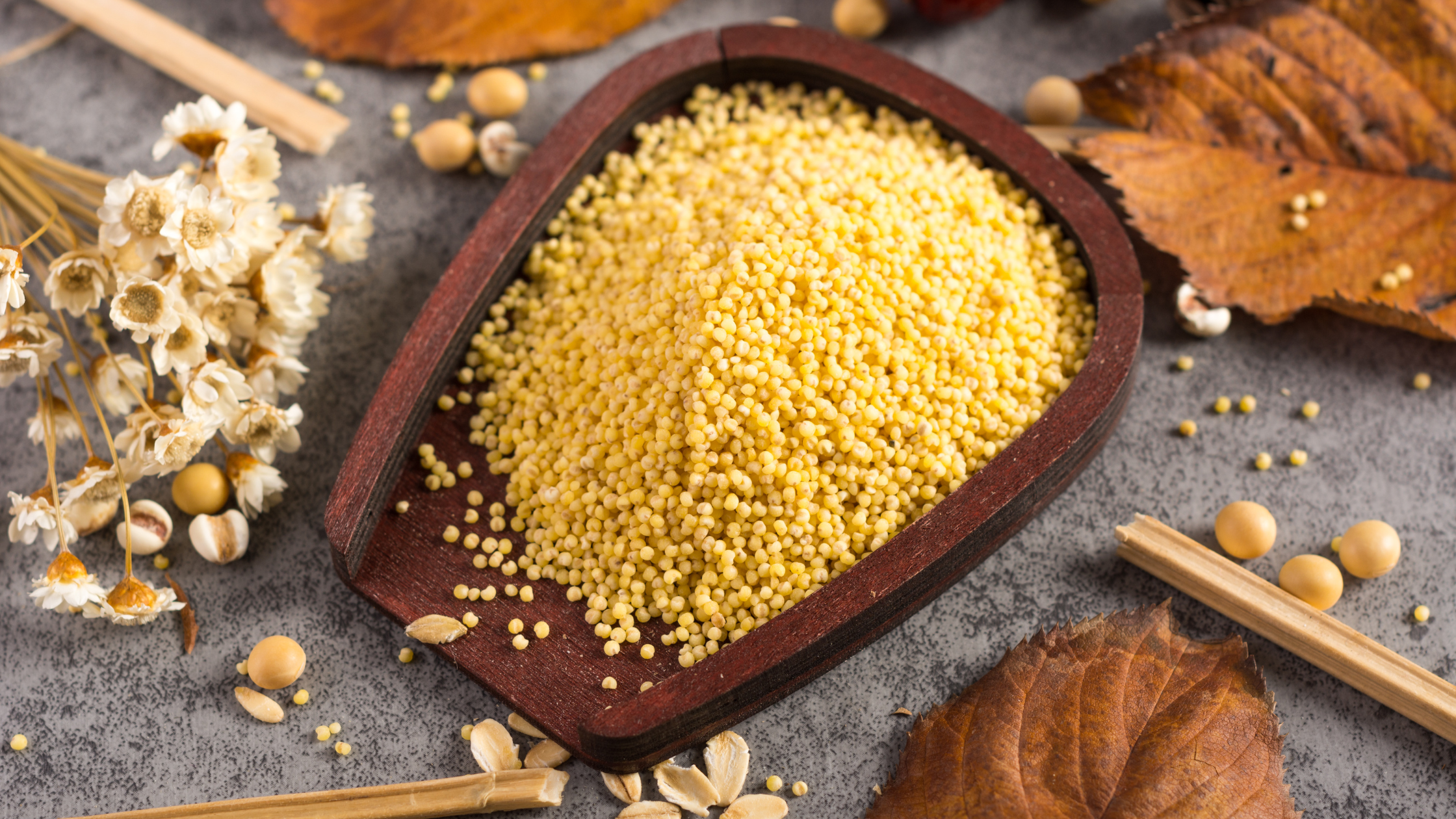
Marvelous Millet
Health benefits, climate change, and nutrition of this little known grain
Millet is a not-well- known small-seeded grass that qualifies as a grain and which that has been an important part of human diets for thousands of years. Although not as popular globally as other grains such as rice or wheat, millet offers a number of healthy benefits and is an important food crop in Asia and Africa. The term millet is a bit of a misnomer as there are a number of millets. They are classified as either large or small millets. The large millets include the finger, foxtail, pearl proso, or ragi varieties while the smaller millets are adlay, or Job’s tears, barnyard, browntop, fonio, Guinea, little, and Kodo.
Due to their nutritional and health benefits, their ability to grow well in arid land, their climate change resilience, and the cultural significance of millets, 2023 was announced as the International Year of the Millets by the Food and Agriculture Organization of the United Nations.
Understanding the health benefits of millet
- High in nutrients - Millet is an excellent source of essential amino acids as well as B vitamins, magnesium, and phosphorus. Due to the amino acid content it also provides protein with 1 cup of cooked millet yielding 6 grams of protein. It also has calcium, with finger millet providing the highest levels of calcium for any grains.
- Fiber - As a cereal grain millet also provides fiber, both soluble and insoluble. Fiber is important for digestive support, bowel health, microbiome support, and high fiber foods can bind with cholesterol to help transport it out of the body.
- Highly antioxidant - In studies of finger millet eighteen different flavonoids, including catechin and epicatechin, plus seventeen phenolic compounds were shown to be part of the millet. This makes it a good choice for dietary antioxidant support.
- Health supporting - Due to the fiber and nutrient density millet has been studied for any support it might offer for overall health and wellness. Studies indicate that it can be helpful for slowing down digestion as well as the impact of glucose on blood sugar levels. Millet also appears to help balance blood pressure levels and may be supportive for lower lipid levels as well.
- The potential for weight management - studies show that millet is not only helpful for regulating blood sugar blance, consumption also appears to delay gastric emptying and it has a high satiety factor. This means you feel full and satisfied for longer and potentially don’t eat as much.
Things to watch out for when eating millet
As with any food, there can be some challenges when it comes to eating millet. Obviously if there are any concerns about allergies or sensitivity it should be avoided. A few other things to keep in mind about the health impct of millet are:
- Soaking required - millet contains phytates and tannins both of which can interfere with the absorption of some of the nutrients in the millet. In order to help reduce the phytates and tannins soaking is recommended. The soaking will also help to make the millet cook faster. For hulled millet (with the hull still attached) soaking for 12 hours is recommended. For pearl, or unhulled, millet a 2 hour soak time should be sufficient.
- Goitrogens - millet is high in goitrogens, a substance that may impact thyroid function and can inhibit iodine absorption. Soaking and rinsing can help reduce the goitrogenic level. This is especially important for those with thyroid health conditions.
Overall millet can be a good nutrient dense option to add to your diet. If you’re not familiar with millet, here are a few recipes to help you get started using this nutritious, gluten free grain. Please note all recipes assume that you are already soaked and dried the millet in advance before adding it to the recipes.

Millet Vegetable Stew
Ingredients
- 1/2 cup soaked and dried millet
- 1 tablespoon olive oil
- 1 medium onion, finely chopped
- 2 garlic cloves, minced
- 2 carrots, peeled and diced
- 2 celery stalks, diced
- 1 red bell pepper, diced
- 1 zucchini, diced
- 1 cup diced tomatoes (canned or fresh)
- 4 cups bone broth - can use vegetable broth if desired
- 1 teaspoon paprika
- 1/2 teaspoon cumin
- 1/2 teaspoon turmeric
- 1/4 teaspoon cayenne pepper (optional)
- Salt and pepper to taste
- 1 bay leaf
- Fresh parsley or cilantro, chopped, for garnish
Instructions
- In a dry saucepan over medium heat, toast the millet for about 2-3 minutes until it becomes lightly golden and emits a nutty aroma. Remove the millet from the pan and set it aside.
- Add olive oil to the pan and set to medium heat.
- Add the chopped onion and sauté for 2-3 minutes until it becomes translucent and fragrant.
- Add in the minced garlic and cook for another 30 seconds until fragrant.
- Add the diced carrots, celery, red bell pepper, and zucchini to the saucepan and cook for 5 minutes, stirring occasionally, until the vegetables begin to soften.
- Add the broth, diced tomatoes, bay leaf, paprika, cumin, turmeric, cayenne pepper (if using), salt, and pepper and bring to a boil before reducing heat to low, cover the saucepan with a lid, and let the stew simmer for 20-25 minutes until the vegetables are tender
- Add the toasted millet to the stew and stir well to combine, continue to simmer for an additional 10 minutes or until the millet is fully cooked and has absorbed some of the broth.
- Ladle stew into bowls and garnish with parsley or cilantro
- Note: This stew also does well when substituting other vegetables such as peas, sweet potatoes, or kale.
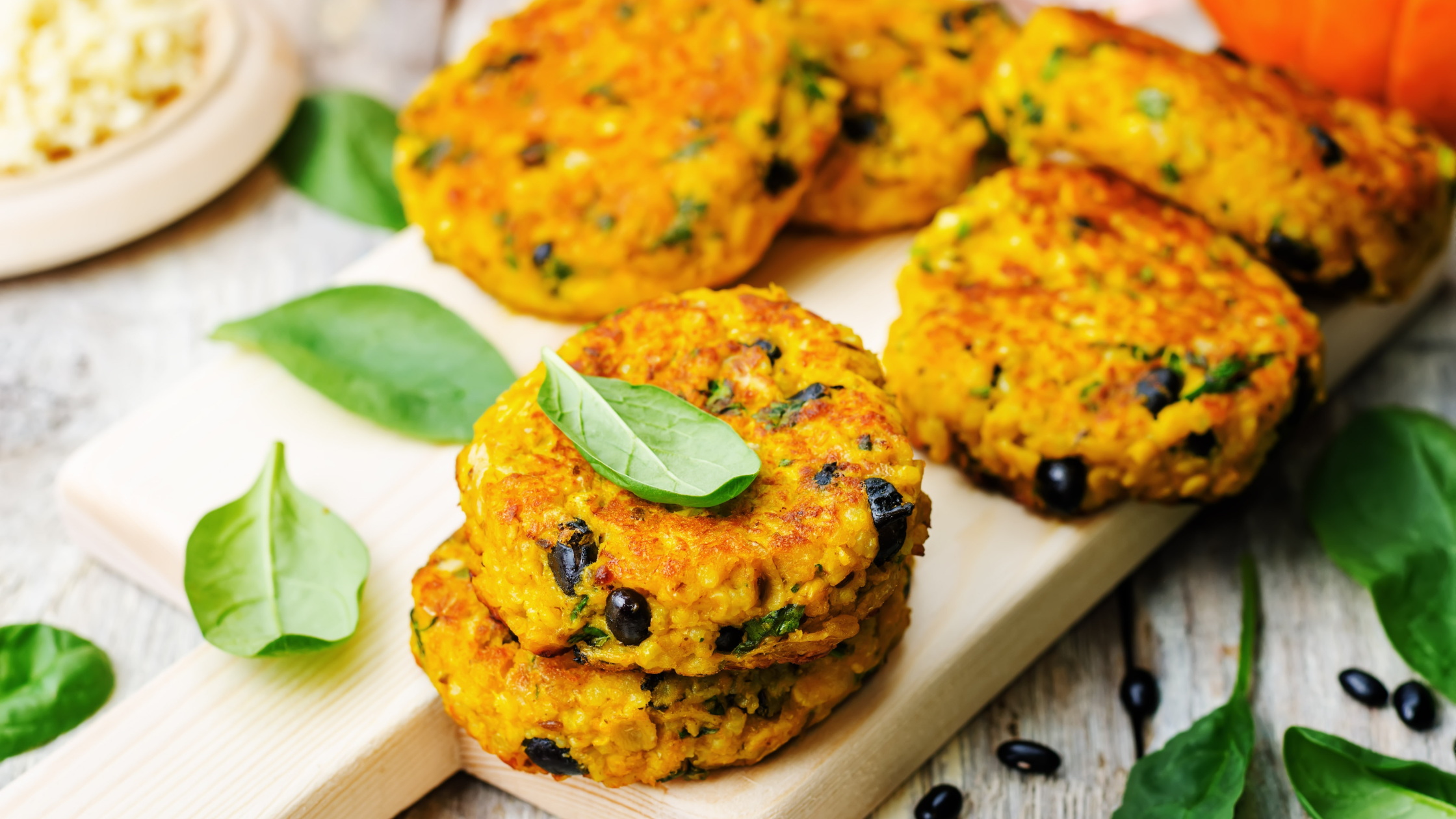
Millet-Black Bean Burger
Ingredients
- 1/2 cup soaked millet
- 1 cup vegetable broth (or water)
- 1 tablespoon ground flaxseed
- 3 tablespoons water
- 1/2 cup grated zucchini
- 1/2 cup grated carrot
- 1/4 cup finely chopped onion
- 2 garlic cloves, minced
- 1/4 cup cooked black beans
- 2 tablespoons chopped fresh parsley
- 1 teaspoon ground cumin
- 1/2 teaspoon paprika
- 1/4 teaspoon chili powder
- Salt and pepper to taste
- 2 tablespoons olive oil
Instructions
- Add the vegetable broth (or water) to medium saucepan and bring to a boil.
- Add the soaked millet, reduce the heat to low, cover the saucepan with a lid, and simmer for about 15-20 minutes or until the millet is tender and has absorbed most of the liquid. Once cooked, remove the millet from the heat and let it cool slightly.
- In a small bowl, mix ground flaxseed with 3 tablespoons of water. Let it sit for a few minutes until it forms a gel-like consistency, creating a flaxseed "egg."
- In a separate, large, mixing bowl add the grated zucchini, grated carrot, chopped onion, and minced garlic and stir well to combine. Then add the cooked black beans and mash them using a fork or potato masher. Leave some texture for added bite in the burger.
- Next add the cooked millet, flaxseed, and spices, mixing everything together until well combined, the mixture should be slightly sticky and moldable.
- Divide the mixture into two equal portions and shape into a patty, pressing firmly so all ingredients stick together, then place patties on a parchment paper lined plate, cover, and refrigerate at least 30 minutes.
- Add olive oil to a medium skillet, when the oil is hot gently add the chilled patties to the skillet. Cook 4-5 minutes on each side until golden brown and slightly crispy.
- Serve the burgers on your favorite gluten-free buns or lettuce wraps with your choice of toppings such as fresh lettuce, sliced tomatoes, sliced onion, or avocado.

Lemon Millet Muffins
Ingredients
- 1/2 cup coconut oil
- 1 cup sucanat
- 1/2 cup evaporated cane juice crystals
- 1 lemon
- 2 eggs
- 1/2 cup almond milk, approximately
- 1 cup gluten free flour mix (I used a combination of oat, rice, buckwheat, tapioca)
- 1/4 cup fresh ground flax seeds
- 1/4 cup (heaping) millet seeds
- 1 teaspoon baking soda
- 1/2 teaspoon sea salt
Instructions
- Preheat oven to 350 F
- Grease three mini-muffin pans (or one regular muffin pan)
- Zest the lemon
- Juice the lemon and put juice into a measuring cup
- Add almond milk until there is 2/3 cup liquid
- Beat together coconut oil and sugars until fully combined
- Add eggs, one at a time until well mixed
- Add lemon zest, baking soda, and the salt
- Alternate adding flour and curdled milk, making sure they are well mixed
- Spoon by tablespoonfuls into muffin cups
- Bake 15 minutes
- Let cool 2 minutes in the pan
- Finish cooling on a wire rack
In conclusion
Although 2023 was designated as the 2023 International Year of the Millets by the Food and Agricultural Organization of the United Nations, millet tends to be a somewhat unknown grain outside of those areas where it has a strong cultural heritage. Packed with nutrition and offering a number of health benefits, it can be an excellent choice as a nourishing gluten free grain.
As with any food, moderation and mindful consumption are key to reaping the best rewards from this ancient and nutritious grain.

How To Shop Smart At Dollar Tree
Groceries are a moving target in the retail world, and stores like Dollar Tree are evolving to capture the shifting focus of consumers' food dollars.
In response to the increasing cost of groceries, Dollar Tree is expanding its reach into the market. They plan to install more cooler cases for cold and freezer items, aiming to add approximately 16,000 new cooler doors nationwide.
Shopping Smart
As Dollar Tree ventures into a wider array of grocery offerings, customers are tasked with shopping smarter. It's essential to not only consider the price but also the nutritional value of your purchases.
Here's what to remember:
- Size and Value: Budget stores might offer different product sizes, making a Grocery Price Tracking Worksheet a vital tool for smart shopping. Often the budget grocery stores look like a deal until you really compare the prices per ounce rather than per package.
- Quality Over Cost: Inexpensive doesn't always equate to healthy. It's important to read labels and choose items that offer nutritional value. Due to their focus on low cost, many budget stores choose to carry cheap products which are usually low in nutrient density. Your body and your health are worth paying more for real food.
- Strategic Purchases: Dollar Tree's multiple price points can lead to larger basket sizes. Know your prices and don't be lured into false deals.
- Efficient Shopping: Avoid the trap of convenience. Just because you're already at Dollar Tree doesn't mean you should compromise on value or nutrition.
- Instant Gratification: While you know snacks and candies aren’t great, if you’re walking aisle after aisle looking for the good deals you may get decision fatigue and succumb to a treat. Or two. And once it comes into the house someone is going to eat it. Don’t do that. Use the same strategy I encourage when shopping at any grocery store. Don’t shop hungry and always grocery shop with a list.
The journey through budget grocery shopping is filled with both opportunities and pitfalls. The key is to shop with intention, keeping both your budget and health in mind. By being mindful and informed, we can navigate the aisles of Dollar Tree and other budget stores without compromising on our standards for nutrition and well-being.
Be prepared
Groceries aren’t the only thing you can get at Dollar Tree. It’s also possible to buy emergency preparedness supplies there. Every Dollar Tree is different, so you’ll need to think about what you might need and then check the aisles to see if your store has those supplies. If needed you may want to check out more than one Dollar Tree in your area.
Here’s what I found at mine:
- Safety goggles
- Lighter
- Mini flashlight
- Headlamp flashlight
- A pair of gloves (with a suggestion to also have a pair of heavy-duty gloves in your car)
- Bungee cords
- Paracord
- Glow bracelets
- Push light
- Essentials for a first aid kit
- Paper tape
- Regular tape (with a recommendation to include duct tape)
- Lanyard-style glow sticks
When shopping at the Dollar Tree, or any low cost store, be strategic, be healthy, and most importantly, be savvy with your dollars.
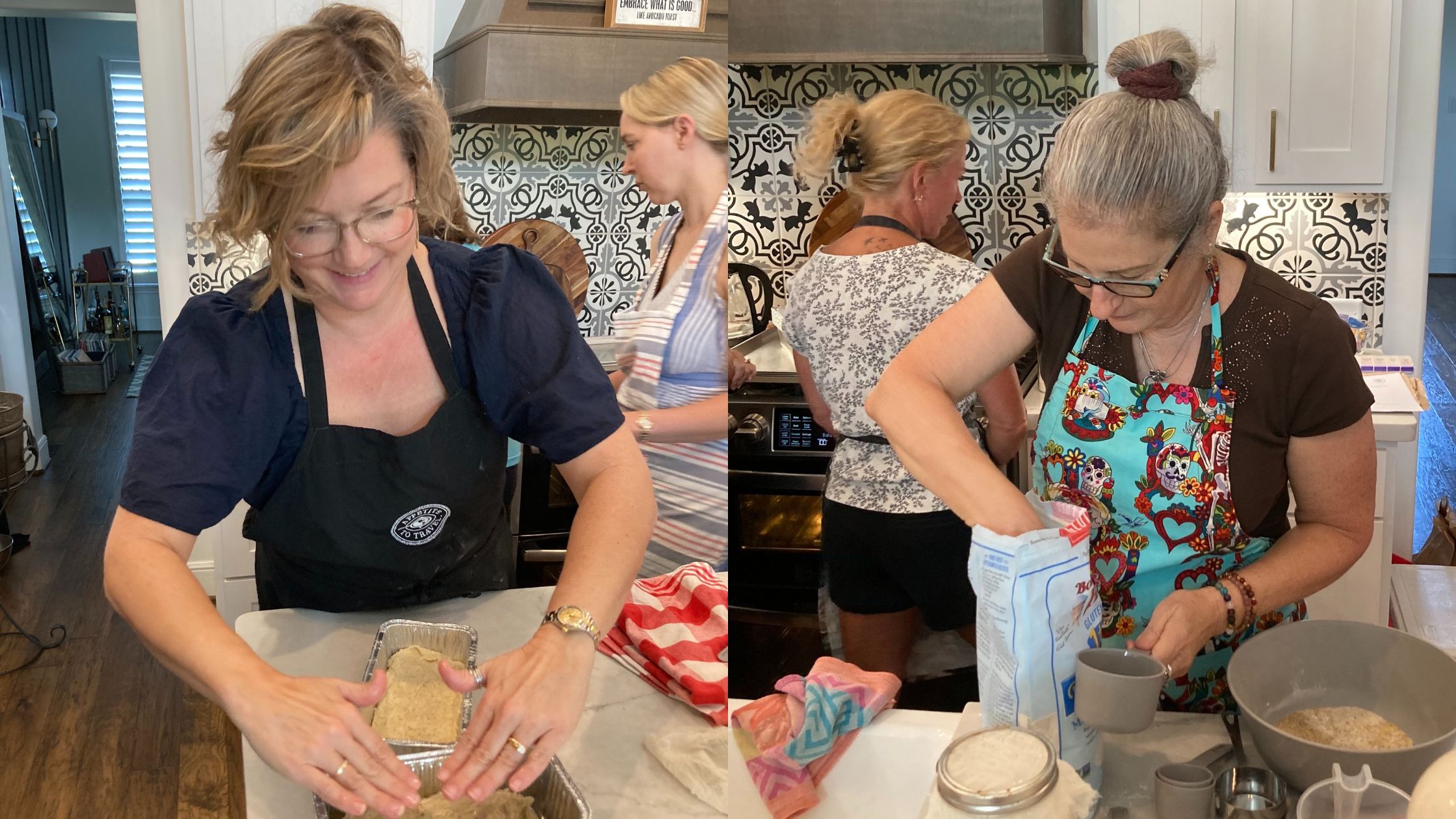
Gluten Free Sourdough Baking Class
Recently I was invited to take part in a gluten free sourdough baking class. Taught by Kasey Lobb, a registered dietician nutritionist, the class promised to teach us how to make a delicious gluten free sandwich loaf from scratch. We would also go home with a starter of our very own in order to replicate the process in our own kitchens.

I confess I love cooking classes. It’s super fun to teach them and I certainly enjoy doing that, but it’s also great when you have a chance to take a class and learn from someone else. Kasey was a wonderful instructor.
The class was held at a friend’s house and there were 10 of us, each paired up so we could share one of the Kitchen Aid mixers. Taking us through the process of what we were doing and a breakdown of the ingredients, Kasey, did a great job of explaining everything.
We started with the liquid ingredients, which included some starter from an impressively large jar. She’d been feeding it for days in order to have enough for the class. It was bubbly and fragrant in that fabulous way that starter is supposed to be. 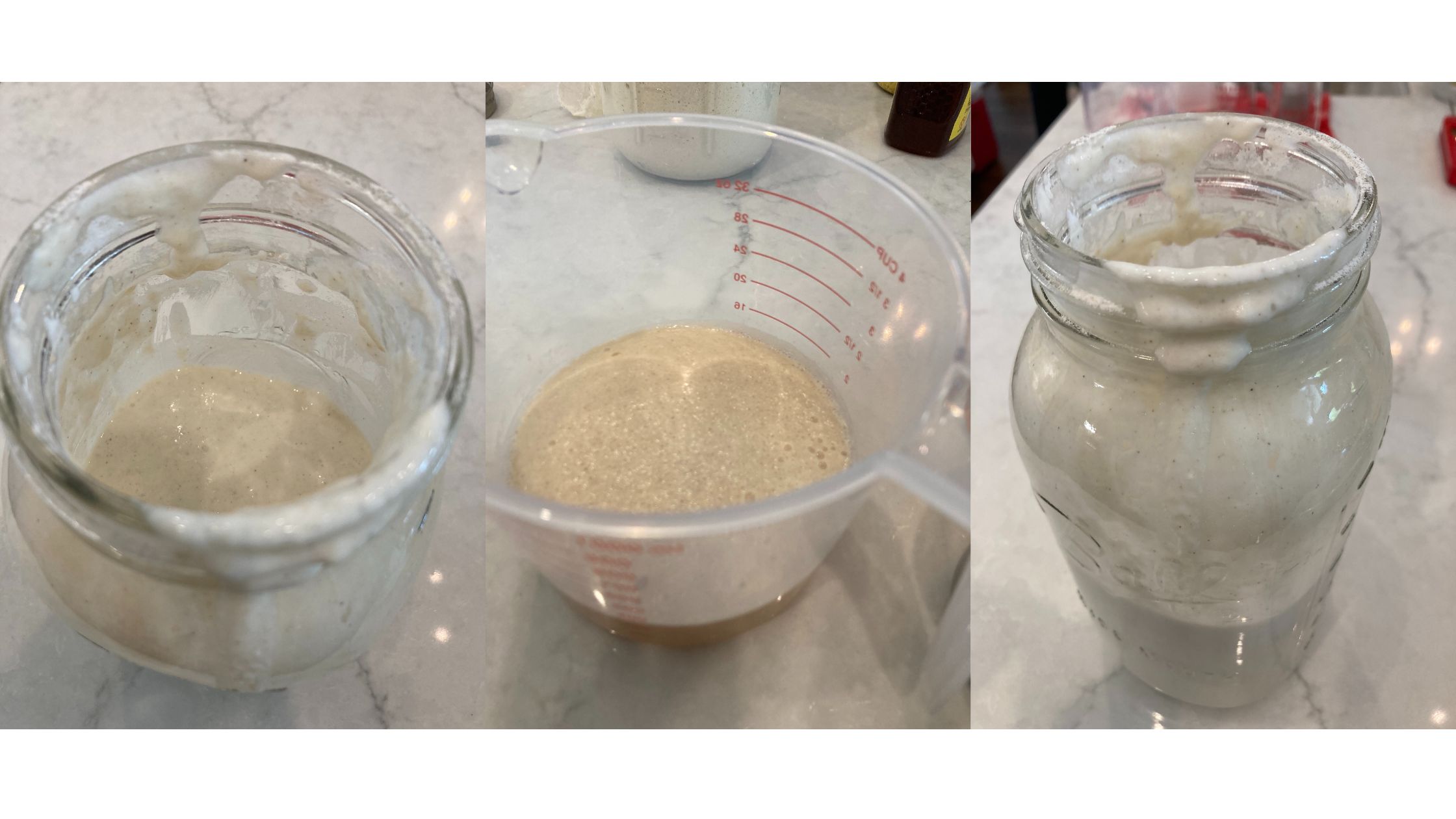
One of the things that I appreciated about the class is how Kasey apparently has a similar mindset when it comes to food labels. She carefully explained each ingredient, why she’d chosen the ones she did, and how everything worked together to support the dough. In addition to the gluten free sourdough base we used egg, sugar, yeast, water, GF baking blend, nutritional yeast, ground flax seeds, and psyllium husk fiber.
After mixing the liquid ingredients we mixed together the dry ingredients and then put them both together. At each step of the process Kasey would demonstrate what we were supposed to be doing and then come around offering assistance if people needed it. She wanted us to not only hear, but also see and understand why it the batter needed to look and feel the way it did.
Eventually we had our beautiful loaves tucked into their loaf pans and from there into the oven. At which point we were able to enjoy a snack that Kasey had prepared of the sandwich loaf we were making that she jazzed up with soaked fruit and seeds. It was mouthwateringly delicious. This bread was so fabulous…how fabulous was it?... everyone wound up going back for a second slice. Nicely dense with a good level of hydration it wasn’t dry like most commercial gluten free breads. Best of all it didn’t have excessive plant gums. It’s one of those breads that doesn’t need anything else, it’s amazing all by itself. 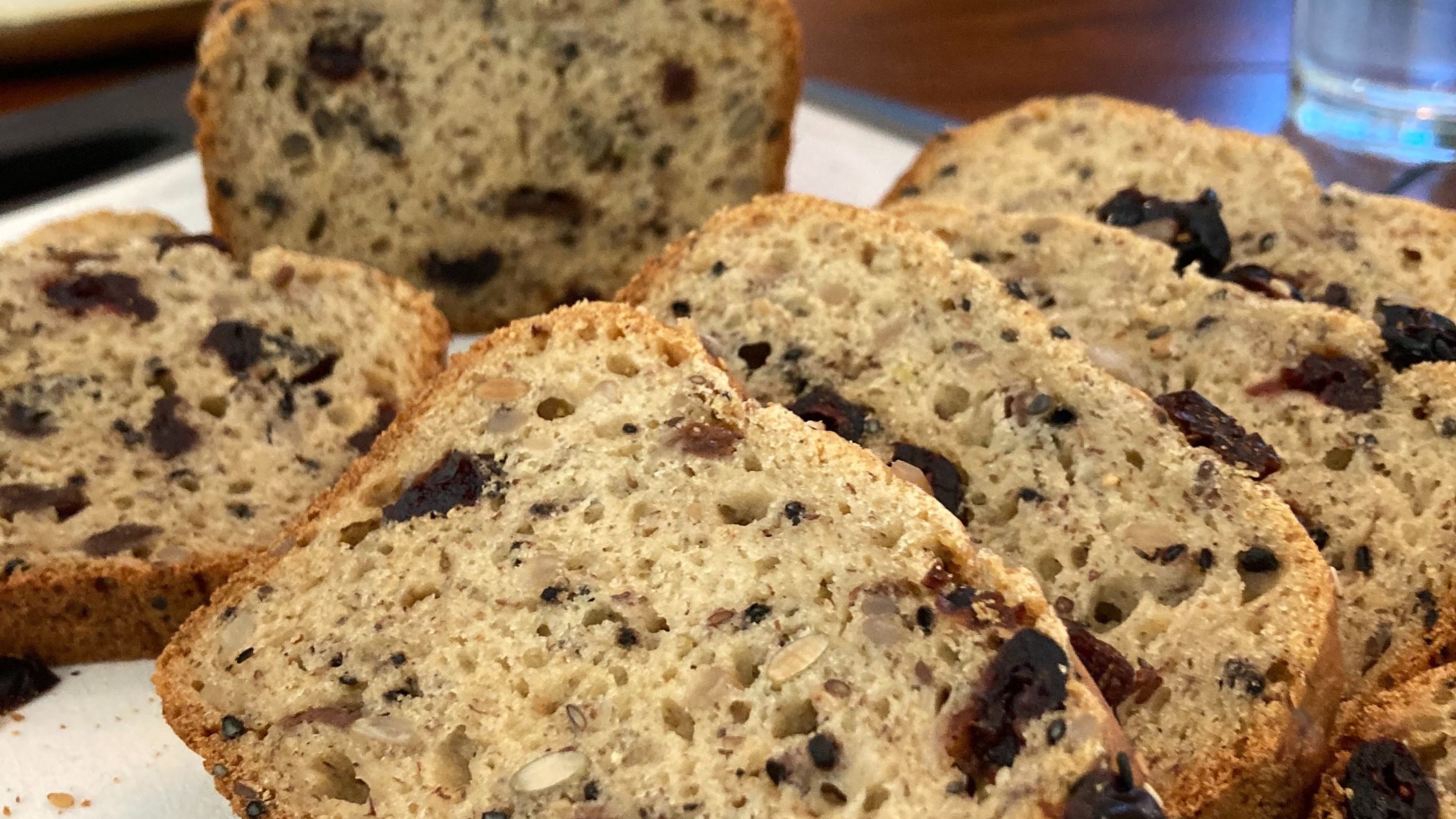
Luckily we were all given the recipe, plus a couple of others to take home with us.
That evening I carefully fed my starter and set it up to make sourdough pancakes for breakfast the next day. My starter is obviously a new one so it’s not super bubbly, however the pancakes were delicious with a hint of sourdough tang.
Now it’s been fed, put to bed, and is waiting for the next baking adventure.
One of the best things about this class for me was learning about a new kind of baking pan that is much better for batter style breads than regular baking pans. It gives the loaf more form so that it can rise higher and will be better for sandwiches.
Here’s the supply list:
- 2.2 pound Pullman Loaf Pan - Made with carbon steel it’s silicon lined with no PFOAs or PFASs, has a vent at the bottom (you use parchment paper when making batter breads), and a lid in case you want perfectly square bread
- Konsyl Psyllium Husk Powder - This helps keep things together since there is no gluten in this mix, it also provides fiber and density for the bread
- Nutritional Yeast - Provides a little bit of B12 and also adds delicious flavor to the bread
- Bob’s Red Mill 1 to 1 Gluten Free Baking Flour - This is Kasey’s recommended blend
- Active Dry Yeast - Slightly different than instant yeast although I believe both would work for making this kind of bread
- Gluten Free Sourdough Starter - If you don’t have the opportunity to take a gluten free sourdough baking class or you don’t have a friend who has starter to share, the good news is you can get your own and start from scratch
It was a wonderful class and I’m delighted that I had the opportunity to spend time learning how to do this. If you’d like to take a class with Kasey be sure to check out her website Appetite To Travel.
If you have the chance to take cooking classes I encourage you to do it. You’ll learn something new, have fun doing it, and gain a new skill that you can add to your kitchen repertoire.

